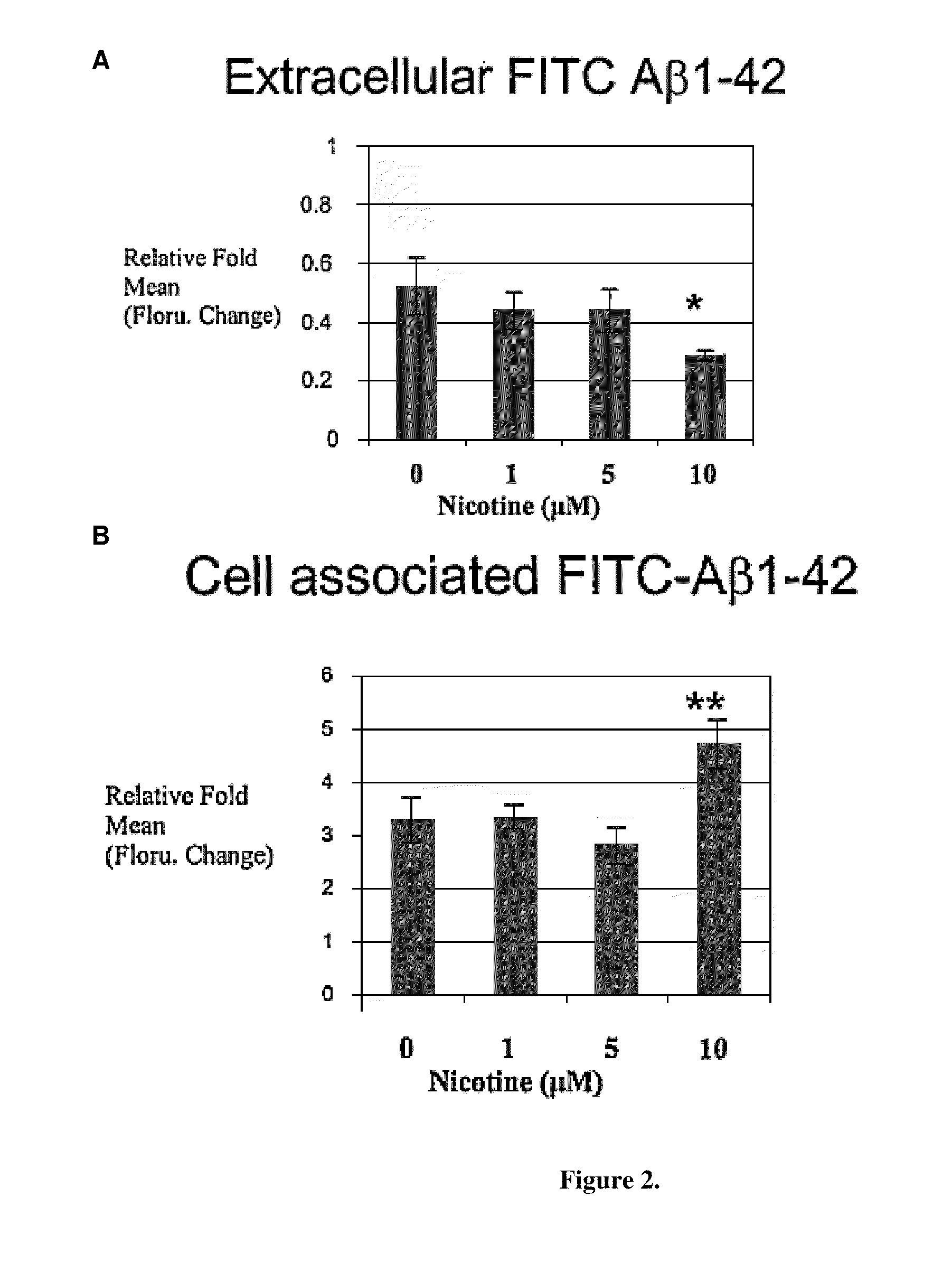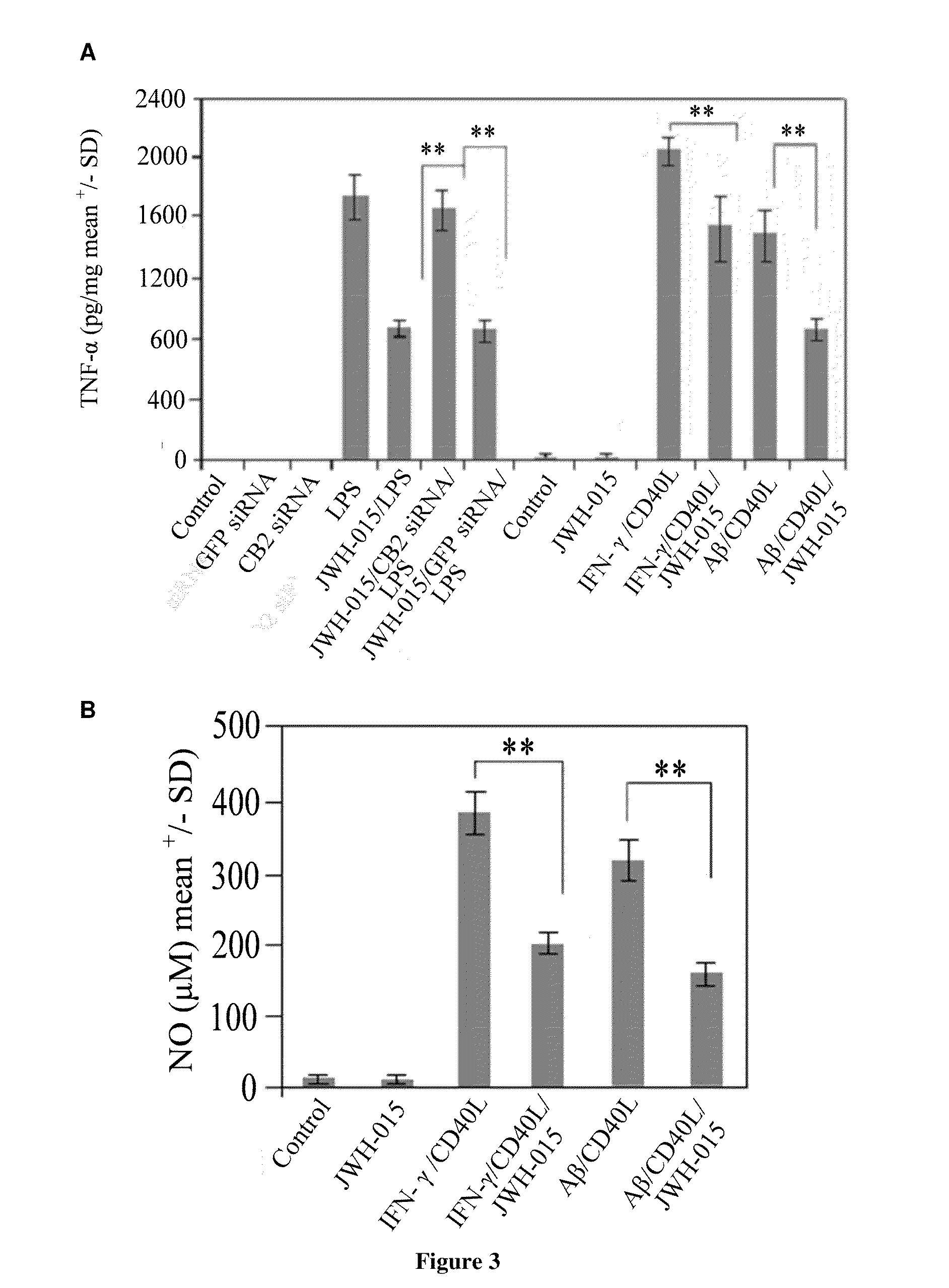Synergistic Modulation of Microglial Activation by Nicotine and THC
a technology of synergistic modulation and microglial activation, which is applied in the direction of biocide, heterocyclic compound active ingredients, drug compositions, etc., can solve the problem that no studies have investigated the neuroimmunological effects of chronic combined nicotin
- Summary
- Abstract
- Description
- Claims
- Application Information
AI Technical Summary
Benefits of technology
Problems solved by technology
Method used
Image
Examples
example 1
Nicotinic / Cannabinoid Combination Treatment Mediates Suppression of Inflammation In Vitro
[0047]Cell cultures were treated with nicotinic / THC treatment, as described above. The concentration response and time-course functions of nicotine / THC treatment were analyzed against the cytokine profiles of microglial cells for TNF-α, IL-1β and IL-6, IL-12 induced by TNF-α and Aβ exposure. Each cytokine was represented as pg of cytokine / mg of total cellular protein. Data was analyzed using ANOVA with post hoc comparison using Bonferroni's or Dunnett's T3 methods as determined by Levene's test for equality of the variances. The combination nicotinic / THC treatment is dose dependent and has synergistic effects in attenuating microglia activation, as seen on TNF-α analysis in FIG. 5.
[0048]These findings suggest that the combination of THC and nicotine clinically have greater efficacy in reducing neuroinflammation with less side effects than either drug given alone. Because of nicotine's short half...
example 2
Nicotinic / Cannabinoid Treatment Effects of Immune Phagocytosis
[0049]Nicotinic and cannabinoid compounds have dose-dependent synergistic effects in attenuating microglia activation. Concentration-response and time-course functions for microglial phagocytosis (cellular uptake) of Aβ1-42 peptide were then characterized. Treatment with nicotine (10 μM) or THC (5 μM) markedly decreased extracellular FITC-Aβ1-42 remaining in the supernatant while increasing cell-associated FITC-Aβ1-42, as seen in FIGS. 2(A) and (B) and 4. This indicates increased capacity of microglial phagocytosis. To fully characterize these effects, primary microglial cells cultured in 24-well tissue-culture plates (1×105 / well) were treated for 0, 15, 30, 60, 120, and 180 mm with “aged” FITC tagged Aβ1-42 peptide at 300 nM in the presence or absence of nicotine (0.1-10 μM), THC (0.01-10 μM), and their combination. The microglia were then administered nicotine (0.1-10 μM), THC (0.01-10 μM) and a combination. In addition...
example 3
Nicotinic / Cannabinoid Treatment Mediates Suppression of Inflammation In Vivo
[0051]TNF-α levels of homogenized brains were examined using ELISA. Adult male C57 / BLB mice received nicotine or THC on the right side of the abdomen as indicated. Treatment was immediately followed by 1 mg / kg LPS on the left side of the abdomen. Two hours later, mice were euthanized and brains were removed for TNF-α cytokine analysis. Bio-Rad protein assay was performed to measure total cellular protein. The combination of THC and nicotine reduce TNF-α levels in the mice, below levels observed in THC or nicotine only levels, seen in FIG. 7, indicating THC / nicotine treatment synergistically reduces microglial activation.
PUM
| Property | Measurement | Unit |
|---|---|---|
| Frequency | aaaaa | aaaaa |
| Frequency | aaaaa | aaaaa |
| Frequency | aaaaa | aaaaa |
Abstract
Description
Claims
Application Information
 Login to View More
Login to View More - R&D
- Intellectual Property
- Life Sciences
- Materials
- Tech Scout
- Unparalleled Data Quality
- Higher Quality Content
- 60% Fewer Hallucinations
Browse by: Latest US Patents, China's latest patents, Technical Efficacy Thesaurus, Application Domain, Technology Topic, Popular Technical Reports.
© 2025 PatSnap. All rights reserved.Legal|Privacy policy|Modern Slavery Act Transparency Statement|Sitemap|About US| Contact US: help@patsnap.com



